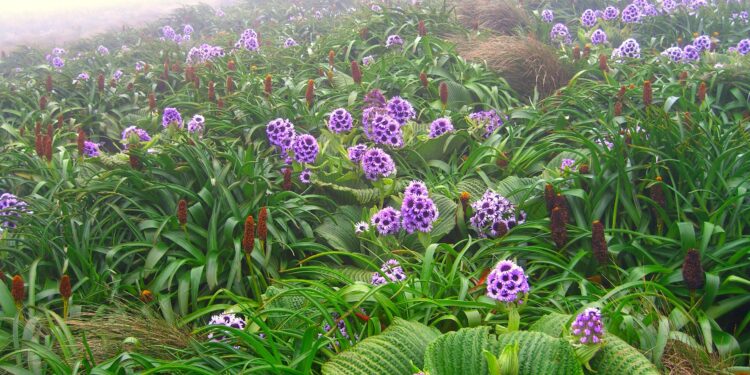Pleurophyllum speciosum is a herbaceous wildflower with bright purple flowers. Credit: Philip Garnock-Jones/University of Göttingen
The Asteraceae, a family of flowering plants, is the most diverse group of flowering plants in the world. This plant family includes about 34,000 species. An international research team with the participation of the University of Göttingen has now compiled and analyzed a new global database on the distribution and evolutionary history of all Asteraceae species.
The researchers found that a surprisingly large number of evolutionary events – known as “speciation” where a new species of plant evolves from a common ancestor – occurred in the aster family over relatively short periods of time on many islands around the world. The findings are published in Nature Communications.
The presence of Asteraceae is characteristic of the flora of remote islands such as the Galapagos, Mauritius and Polynesia. These plants include some of the most spectacular botanical species, from the genus Bidens, meaning “two-toothed”, of the Pacific Islands, to the strange and highly endangered Silverswords of Hawaii, to the giant Scalesia trees of the Galapagos Islands.
Although they are an excellent example of island biodiversity, it has not been possible until now to obtain a complete picture of where these plants fit into the bigger picture.
To address this challenge, researchers in botany and evolutionary biology compiled and analyzed a global database containing information on the distribution and evolutionary history of all Asteraceae species on many islands.
The team found that there are more than 6,000 species of Asteraceae native to islands, nearly 60% of which are found exclusively on islands. Their findings support one of the most important and well-established theories in ecology and evolution, which is that larger, more isolated islands are home to a greater number of unique species.
Many of these species are threatened with extinction and only a few individuals have survived in the wild. “The Asteraceae are a wealth of information that helps researchers understand why and how new species evolve in the world’s most remote environments,” says Professor Holger Kreft, Head of Biodiversity, Macroecology and Biogeography at the University of Göttingen.
The researchers were also able to identify dozens of speciation events, perhaps unknown, on islands around the world. Speciation occurs in a limited geographic area over a period of “only” a few million years. During this process, a common ancestor colonized an island and produced many new species that often differ radically in size, shape, habitat, and other characteristics.
The number of these newly discovered evolutionary events surprised the researchers. “Botanists have long suspected that Asteraceae evolved remarkably on islands, but our study shows that the scale of evolutionary innovation in this family may be much greater than previously thought,” says first author Lizzie Roeble of the Naturalis Biodiversity Center in Leiden, the Netherlands. The findings highlight the importance of protecting this group of plants.
More information:
Lizzie Roeble et al., Island biogeography of the megadiverse plant family Asteraceae, Nature Communications (2024). DOI: 10.1038/s41467-024-51556-7
Provided by Georg-August-Universität Göttingen
Quote:A new database covers the distribution and evolutionary history of a megadiverse flowering plant family on isolated islands (2024, September 20) retrieved September 20, 2024 from
This document is subject to copyright. Apart from any fair dealing for the purpose of private study or research, no part may be reproduced without written permission. The content is provided for informational purposes only.



